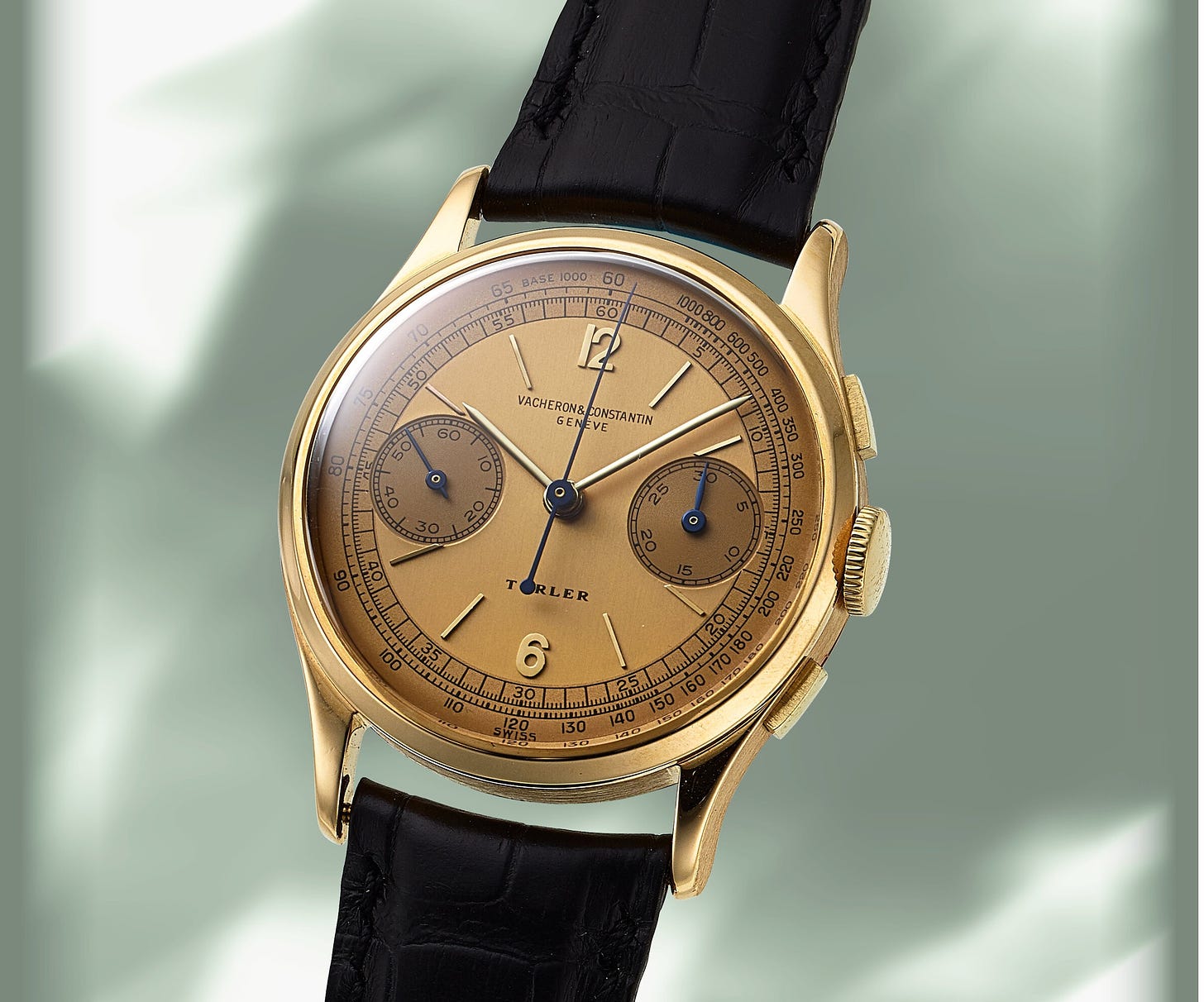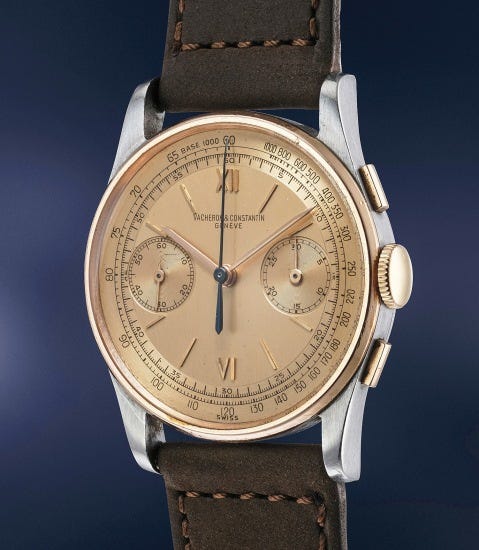Vintage Vacheron Chronographs: Only the Best
Celebrating the enduring heritage and style of the Vacheron ref. 4072
Paul Newman’s Big Red sold for $5.5m, but you probably already knew that. Let’s look past the headlines at a few other watches from this weekend.
Vacheron Constantin 4072: State of the market
While many were tuned into Phillips Racing Pulse this week — including us — Heritage Auctions also held its watch sale in Dallas. A number of interesting lots were offered, but my eyes were fixed on this Vacheron Constantin reference 4072 chronograph. It’s a model we wrote about earlier this year, when watchmaker Peter Toot conducted a survey of 80+ sold examples, categorizing the dials into six “variants”. Excitingly for us, Heritage referenced this article in its catalog entry for the ref. 4072, even referring to it as a ‘Variant 2’ in the entry title, as per Mr. Toot’s categorization.
Vacheron produced the two-button reference 4072 from 1938 until the early 1970s. Total production only reached 1178 examples in three metals: yellow gold, rose gold and stainless steel, with a small number of two-tone watches (plus the possibility of several examples in white gold). The Variant 2 dial is characterized by its applied markers, and was the most commonly found variant in our survey, making up roughly half of the observed examples.
The example from Heritage was particularly notable because it was double-signed by retailer Turler. More recently, it was acquired and displayed by Vacheron’s Les Collectionneurs, the brand’s effort to highlight some of its most important vintage timepieces. Heritage sold this example for $45,000, an impressive result for what’s still a relatively small, 36mm, niche chronograph from the 1940s. Last year at Phillips Geneva, we saw a retail-signed yellow gold example (this one by Hausman), similar to this example from Heritage, sell for CHF 38k. So it’s possible the Heritage result even illustrates some appreciation in the ref. 4072 market, though only a fool would call a straight line between two data points a “trend”.
It’s at least the third ref. 4072 we’ve seen at auction this season, with two other examples having surfaced in Geneva last month. At Phillips Geneva XII, a two-tone steel and pink gold example sold for CHF 63k. This same example sold just a year prior at Sotheby’s for CHF 66k, perhaps a reminder that, while there is a strong collector appreciation for vintage Vacheron, it remains a relatively small niche of the collecting world, and you shouldn’t buy one expecting to flip it for a profit in 12 months (not that you should buy any watch for such repugnant reasons).
Antiquorum also sold a nice-looking pink gold example with a pulsation scale, this lot for CHF 44k. Notably, all three of the examples sold this season feature the most-common “Variant 2” dial with applied markers and outer scales, with all three movement numbers separated by less than 100 digits, indicating the production year of all would have been at most a couple years apart in the ‘40s. To summarize the fall results for the Vacheron ref. 4072:
Heritage Auctions, Variant 2 dial (retailed by Turler): $45k
Phillips Geneva XII, Variant 2 dial (two-tone case): CHF 63k
Antiquorum Geneva, Variant 2 dial (pulsation scale): CHF 44k
Of course, the Phillips result is the outlier, but isn’t that always the case? Further, the Phillips lot featured a two-tone case (the mid-case of which was stainless steel), and stainless steel examples of the ref. 4072 are exceedingly rare. So, perhaps that particular result is justified by more than hype and a charming auctioneer, especially considering it’s a lower result than achieved at Sotheby’s a year prior for that same watch.
There’s also a lesson (as always) to be learned here about condition. While these last few examples have had no problem matching (or surpassing) estimates, that’s not been the case with every ref. 4072 we’ve seen. For instance, one example was passed on at Antiquorum, twice — first last December, and then again this March.
You’ll see some damage and slight oxidation on the dial, and additional damage to the yellow gold case. Even lowering the estimate for the second auction (to half that of the results we saw for the sold examples above) didn’t gin up any additional interest in this particular example. What to make of this? It’s tough to say, but in a world where exciting watches pop up every day, if an example’s not in top condition, no matter how desirable the reference, it whiles away unsold. That’s why, for example, a sharp, clean Movado M95 can go for nearly $20k, while a Vacheron chrongraph can’t even garner a bid of that amount in two tries.[1]
Heritage and style
Also of note from Heritage: the sale of another Cartier Crash 1991 Paris Edition for $87.5k. I wrote at length[2] about the model last week, but the larger point is this: Sure, the Crash is a great watch, but as collectors we need to look past the headliners and record-breaking results to identify other potential icons, the ones no one else is paying attention to. Even with a string of strong results, the Vacheron ref. 4072 might be one of these icons.
When asked to choose a favorite among Vacheron’s three classic chronographs, Christian Selmoni, the brand’s Heritage and Style Director said: “If I have to make a choice, it would be the 4072 because it was introduced in the mid-1930s and production continued into the early 1970s. Having come through four decades, it is a lesson in longevity. Its classic style has endured regardless of changing fashions, all the while evolving to reflect technical developments.”
Listen, no celebrities or historical figures have been seen wearing a vintage Vacheron ref. 4072. Even today, it rarely graces the cover of auction catalogs, and I’m not sure I’ve seen one posted on Instagram.com more than a few times. But complicated vintage Vacherons are rare treasures, with the brand producing them in extremely limited quantities to ensure that only the best timepieces were manufactured. Even Vacheron itself celebrates the importance of the ref. 4072. We should too.
Rescapement is a weekly newsletter about watches, mostly vintage. Subscribe now to get it delivered to your inbox every Sunday.
Jealously List 2020
Next up, Rescapement’s first annual Jealousy List — stories from other publications throughout the year that deserve recognition, and that I perhaps wish I’d written myself. Much the way a collector might become wrought with jealousy when seeing a wrist shot or insufferable “new watch alert” featuring a timepiece they themselves had been eyeing, I experience the same feeling of emotional pain when another outlet publishes a great piece of writing.
What starts as a begrudging tip of the cap though, eventually becomes something more sincere. Game recognize game, as the kids (used) to say. The focus here is on timeless pieces — articles that will be as relevant in 10 years as they were on the day published. With that, enjoy at my envious expense the 2020 Jealously List.
Swatch: The last great innovation in horology
A Collected Man
This is the year A Collected Man became perhaps the best content producer in the business. However, my favorite article from them wasn’t their bread-and-butter forte about six-figure independents, but rather their exploration of Swatch. In the piece, John Goldberger refers to Swatch as “the last real innovation in the history of horology” — it’s fascinating to read about Mr. Goldberger’s collecting of the plastic, quartz tickers, despite the fact that he still says he won’t let one touch his wrist.
On not picking a birthday watch
Jason Heaton
Jason Heaton’s article on not getting a watch for his 50th birthday is Hemingway-esque in its simple profundity. This passage reflecting on the meaning of Rolex and the American Midwest hit home for me:
Where I come from, I didn't see anyone wearing Rolex. While many from the coasts and Europe saw fathers and role models wearing old Subs and Datejusts, in the American Midwest, the Crown is largely seen as ostentatious, impractical, and pretentious. So while I was spending time in New York, Geneva, and more far-flung post codes where Rolex is common, coming back home with one on usually meant having something to explain, if not to others, at least to myself. This forced me to examine what it was that I liked about Rolex specifically, and about watches in general. And it really had nothing to do with the name on the dial or any prestige associated with it.
The complete history of Patek Philippe vintage chronographs
Wei Koh, Revolution
Wei Koh starts this in-depth exploration of vintage Patek Philippe chronographs by explaining his unrequited, unfulfilled love of the Patek reference 1463 “Tasti Tondi”, the brand’s first water-resistant chronograph:
A watch that is so hallucinatory in its beauty that if you were able to bring back the ghosts of Gérald Genta, Michelangelo, Leonardo da Vinci and Phidias, and lock them in a room for one hundred years, they would not have been able to design a chronograph that could surpass the beauty of the 1463. But what I love most about the Tasti Tondi is that as Patek Philippe’s one and only water-resistant vintage chronograph, it was a symbol of modernity and adventure in the context of the 1940s and ’50s.
Koh goes on to explore Patek’s entire (and I mean entire) range of vintage chronographs. Despite the decidedly not-woke optics of analogizing wristwatches to women, this 10k+-word opus is a true must read.
Reference Points: Understanding the GMT-Master
Jon Bues & Eric Wind
Every GMT-Master reference from Rolex, from the 6542 to the modern Pepsi and Batman — 35, in all, spread across one table. It’s so good, and perhaps the most ambitious video and project of 2020. For 10+ more articles and podcasts, head to the full list:
Sales Corner
Universal Geneve Uni-Compax ‘Big Eye’
Recently, I went in-depth on the Universal Geneve Uni-Compax, especially the “Big Eye” of the 1960s, the true bad ass of Universal Geneve’s 1960s collection. The Uni-Compax had long been a stalwart of Universal Geneve’s catalog, but never like this. It’s a simple two-register chronograph, but with the Big Eye, Universal boldly pushed what had previously been a staid dress chronograph into a new era.
Produced for just a couple of years in the mid-1960s, there are supposedly only about 30 Big Eyes known to the market (I’ve been told 14 black and 12 white dials have been found), so it’s a big deal when a fresh-to-market one shows up. But this week, Menta Watches has a fresh ref. 884100/02 panda dial up for sale, listed for $18,500. Get your eye on Menta’s Big Eye here.
Through the Wire
✈️ A Collected Man has a Rolex Air-King Date ref. 5700 for sale; it’s a relatively difficult reference to find, despite being one of Rolex’s longest produced models — much rarer than the standard Air-King ref. 5500 (with no date). It’s a reference I’ve been learning more about and hope to explore in-depth soon.
🏎 Tag Heuer’s new online magazine chats with Heuer collectors Nicholas Biebuyck and Eric Wind, see Part 1 and Part 2.
📰 Substack’s CEO (the platform this very newsletter uses) talks about the future of media. His vision of empowering writers to create direct relationships with their readers is one I fully believe in, and I hope more, independent watch publications come to embrace it too.
[1] A Collected Man also has a yellow gold ref. 4072 for sale right now.
[2] In last week’s newsletter, I also mentioned the Cartier Tortue Monoposuher CPCP at Phillips Racing Pulse as “relatively under appreciated”, though I did say it’d blow past its estimate of $8k-12k. That said, I wouldn’t have predicted the $50k it achieved yesterday.












